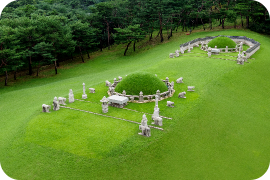


The royal tombs comprise the forty-two tombs of the seventy-three rulers and their consorts of Joseon (1392-1897) and the Korean Empire (1897-1910). Established based on the state ideology of Confucianism, the Joseon dynasty was meticulous in its construction and management of the graves of the royal ancestors according to the virtues of filial piety and ceremonial propriety. The construction of a royal or imperial tomb typically began with a quest to find the most auspicious site based on the principles of pungsu (or feng shui). Each tomb had to be located in the capital area not far from the royal palace so that the reigning kings could make frequent visits to their ancestral graves. The construction of the royal tomb followed the discovery of an auspicious site. Construction entailed dividing the site into three sections: a section where the spirits of the king and his queen consort(s) were laid to rest in everlasting peace, a section where ceremonies honoring their virtues and achievements were held, and a landscaped section which enclosed the tomb in a state of natural harmony with its surroundings.
The royal tombs of Joseon are a rare example of tombs of an entire dynasty that have been almost entirely preserved in their original condition. More remarkably, the construction and management of each of these royal tombs, which took five months on average from discovering the burial site to completion of the tomb, were recorded in detail in the protocols and chronicles called Uigwe and Neungji, respectively. The annual memorial rites to the royal ancestors of the Joseon dynasty are still held today in the precincts of the tombs, making them a tangible heritage of the traditional virtues of filial piety and ceremonial propriety maintained by the Korean people.
| Historic Site | Royal Tomb Name | Royal Tomb Owner | Form |
|---|---|---|---|
|
East Nine Royal Tombs, Guri |
Geonwolleung |
King Taejo |
Single Burial |
|
Hyeolleung |
King Munjong, and Queen Hyeondeok |
Double Hill Twin Burials |
|
|
Mongneung |
King Seonjo, Queen Uiin, and Queen Inmok |
Double Hill Twin Burials |
|
|
Hwireung |
Queen Jangnyeol, the Second Consort of King Injo |
Single Burial |
|
|
Sungneung |
King Hyeonjong, and Queen Myeongseong |
Twin Burials |
|
|
Hyereung |
Queen Danui, the First Consort of King Gyeongjong |
Single Burial |
|
|
Wolleung |
King Yeongjo, and Queen Jeongsun |
Twin Burials |
|
|
Sureung |
Honorary Emperor Munjo and Honorary Empress Sinjeong |
Double Burial |
|
|
Gyeongneung |
King Heonjong, Queen Hyohyeon, and Queen Hyojeong |
Triple Burials |
|
|
Heolleung and Illeung Royal Tombs, Seoul |
Heolleung |
King Taejong, and Queen Wongyeong |
Twin Burials |
|
Illeung |
King Sunjo, and Queen Sunwon |
Double Burial |
|
|
Yeongneung and Nyeongneung Royal Tombs, Yeoju |
Yeongneung |
King Sejong, and Queen Soheon |
Double Burial |
|
Nyeongneung |
King Hyojong, and Queen Inseon |
Single Hill Twin Burials |
|
|
Jangneung Royal Tomb, Yeongwol |
Jangneung |
King Danjong |
Single Burial |
|
Gwangneung Royal Tomb, Namyangju |
Gwangneung |
King Sejo, and Queen Jeonghui |
Double Hill Twin Burials |
|
West Five Royal Tombs, Goyang |
Gyeongneung |
Honorary King Deokjong and Honorary Queen Sohye |
Double Hill Twin Burials |
|
Changneung |
King Yejong, and Queen Ansun |
Double Hill Twin Burials |
|
|
Myeongneung |
King Sukjong, Queen Inhyeon and Queen Inwon |
Double Hill Twin Burials |
|
|
Ingneung |
Queen Ingyeong, the First Consort of King Sukjong |
Single Burial |
|
|
Hongneung |
Queen Jeongseong, the First Consort of King Yeongjo |
Single Burial |
|
|
Seolleung and Jeongneung Royal Tombs, Seoul |
Seolleung |
King Seongjong, and Queen Jeonghyeon |
Double Hill Twin Burials |
|
Jeongneung |
King Jungjong |
Single Burial |
|
|
West Three Royal Tombs, Goyang |
Huireung |
Queen Janggyeong, the Second Consort of King Jungjong |
Single Burial |
|
Hyoreung |
King Injong, and Queen Inseong |
Twin Burials |
|
|
Yereung |
King Cheoljong, and Queen Cheorin |
Twin Burials |
|
|
Taereung and Gangneung Royal Tombs, Seoul |
Taereung |
Queen Munjeong, the Third Consort of King Jungjong |
Single Burial |
|
Gangneung |
King Myeongjong, and Queen Insun |
Twin Burials |
|
|
Jangneung Royal Tomb, Gimpo |
Jangneung |
Honorary King Wonjong and Honorary Queen Inheon |
Twin Burials |
|
Jangneung Royal Tomb, Paju |
Jangneung |
King Injo, and Queen Inyeol |
Double Burial |
|
Uireung Royal Tomb, Seoul |
Uireung |
King Gyeongjong, and Queen Seonui |
Single Hill Twin Burials |
|
Three Royal Tombs, Paju |
Gongneung |
Queen Jangsun, the First Consort of King Yejong |
Single Burial |
|
Sulleung |
Queen Gonghye, the First Consort of King Seongjong |
Single Burial |
|
|
Yeongneung |
Honorary Emperor Jinjong and Honorary Empress Hyosun |
Twin Burials |
|
|
Yungneung and Geolleung Royal Tombs, Hwaseong |
Yungneung |
Honorary Emperor Jangjo and Honorary Empress Heongyeong |
Double Burial |
|
Geolleung |
King Jeongjo, and Queen Hyoui |
Double Burial |
|
|
Hongneung and Yureung Imperial Tombs, Namyangju |
Hongneung |
Emperor Gojong, and Empress Myeongseong |
Double Burial |
|
Yureung |
Emperor Sunjong, Empress Sunmyeong and Empress Sunjeong |
Double Burial |
|
|
Jeongneung Royal Tomb, Seoul |
Jeongneung |
Queen Sindeok, the Second Consort of King Taejo |
Single Burial |
|
Sareung Royal Tomb, Namyangju |
Sareung |
Queen Jeongsun, the Consort of King Danjong |
Single Burial |
|
Olleung Royal Tomb, Yangju |
Olleung |
Queen Dangyeong, the First Consort of King Jungjong |
Single Burial |





